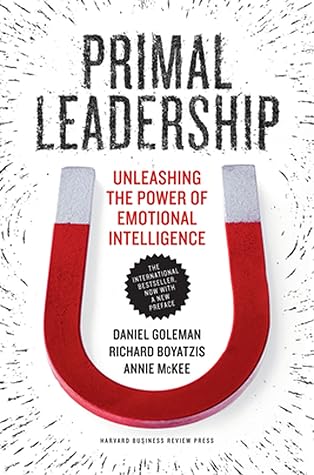More on this book
Community
Kindle Notes & Highlights
Read between
June 6 - August 18, 2020
This whirlwind of change makes it more important than ever for leaders to be self-aware and composed, focused and high energy, empathic and motivating, collaborative and compelling—in short, resonant.
“What Makes a Leader?” and “Leadership That Gets Results.”
The fundamental task of leaders, we argue, is to prime good feeling in those they lead.
That occurs when a leader creates resonance—a reservoir of positivity that frees the best in people. At its root, then, the pr...
This highlight has been truncated due to consecutive passage length restrictions.
In such a grave crisis, all eyes turn to the leader for emotional guidance. Because the leader’s way of seeing things has special weight, leaders manage meaning for a group, offering a way to interpret or make sense of, and so react emotionally to, a given situation.
But the reality is much more primal: Great leadership works through the emotions.
Even if they get everything else just right, if leaders fail in this primal task of driving emotions in the right direction, nothing they do will work as well as it could or should.
The difference between the leaders lay in the mood and tone with which they delivered their messages:
These two moments point to a hidden, but crucial, dimension in leadership—the emotional impact of what a leader says and does.
But research in the field of emotion has yielded keen insights into not only how to measure the impact of a leader’s emotions but also how the best leaders have found effective ways to understand and improve the way they handle their own and other people’s emotions.
Throughout history and in cultures everywhere, the leader in any human group has been the one to whom others look for assurance and clarity when facing uncertainty or threat, or when there’s a job to be done. The leader acts as the group’s emotional guide.
Quite simply, in any human group the leader has maximal power to sway everyone’s emotions.
Followers also look to a leader for supportive emotional connection—for empathy.
When leaders drive emotions positively, as was the case with the second executive at the BBC, they bring out everyone’s best. We call this effect resonance.
relationships. Leaders who maximize the benefits of primal leadership drive the emotions of those they lead in the right direction.
An open-loop system depends largely on external sources to manage itself.
More dramatically, whereas three or more incidents of intense stress within a year (say, serious financial trouble, being fired, or a divorce) triple the death rate in socially isolated middle-aged men, they have no impact whatsoever on the death rate of men who cultivate many close relationships. 3


